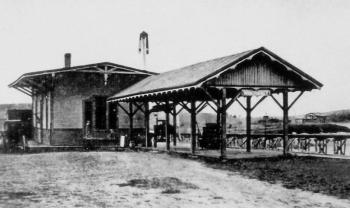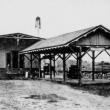Back to the past: Pieces of Wiscasset's history unearthed
 Wiscasset’s former train station on Railroad Avenue circa the early 1900s near the north end of what’s now Railroad Avenue. Courtesy of the Wiscasset Public Library archives
Wiscasset’s former train station on Railroad Avenue circa the early 1900s near the north end of what’s now Railroad Avenue. Courtesy of the Wiscasset Public Library archives
 A news clipping from the 1980s shows when the railroad storage shed was moved from Railroad Avenue. The former train station is shown behind it. Courtesy of the Wiscasset Times archive
A news clipping from the 1980s shows when the railroad storage shed was moved from Railroad Avenue. The former train station is shown behind it. Courtesy of the Wiscasset Times archive
 Wiscasset’s train station was removed from the property in the 1980s after Chase Associates of Edgecomb bought it and moved it to the business's property on Route 27. The roof was removed before the building was moved so it could pass beneath utility wires. Courtesy of the Wiscasset Times archive
Wiscasset’s train station was removed from the property in the 1980s after Chase Associates of Edgecomb bought it and moved it to the business's property on Route 27. The roof was removed before the building was moved so it could pass beneath utility wires. Courtesy of the Wiscasset Times archive
 Wiscasset’s former train station on Railroad Avenue circa the early 1900s near the north end of what’s now Railroad Avenue. Courtesy of the Wiscasset Public Library archives
Wiscasset’s former train station on Railroad Avenue circa the early 1900s near the north end of what’s now Railroad Avenue. Courtesy of the Wiscasset Public Library archives
 A news clipping from the 1980s shows when the railroad storage shed was moved from Railroad Avenue. The former train station is shown behind it. Courtesy of the Wiscasset Times archive
A news clipping from the 1980s shows when the railroad storage shed was moved from Railroad Avenue. The former train station is shown behind it. Courtesy of the Wiscasset Times archive
 Wiscasset’s train station was removed from the property in the 1980s after Chase Associates of Edgecomb bought it and moved it to the business's property on Route 27. The roof was removed before the building was moved so it could pass beneath utility wires. Courtesy of the Wiscasset Times archive
Wiscasset’s train station was removed from the property in the 1980s after Chase Associates of Edgecomb bought it and moved it to the business's property on Route 27. The roof was removed before the building was moved so it could pass beneath utility wires. Courtesy of the Wiscasset Times archive
Bricks, bits of pottery, timber piling and a chimney base were among the remains unearthed by the recent excavation of Railroad Avenue in Wiscasset during the installation of a water main.
The Wiscasset Water District hired archeologist Rick Morris to monitor the digging in November and May. The U.S. Department of Agriculture, Rural Development, the agency funding the estimated $1.36 million project replacing water infrastructure throughout the village, required the monitoring.
WWD Superintendent Chris Cossette said having an archeologist on site was only necessary on Railroad Avenue because it lies within the boundaries of the Wiscasset Historic District designated in 1973.
Because there was a possibility the excavation could uncover remains from the 18th and 19th centuries, the state historical agency requested an archeologist be on site to document any findings, explained Cossette.
Cossette said the monitoring was included within the work carried out by the Portland engineering firm of Tata & Howard.
Morris, the owner of In Depth Archaeology of 382 College St., Lewiston, has over 20 years of experience in cultural resource management and archaeological investigations. The water district gave the Wiscasset Newspaper a copy of his 36-page report detailing the monitoring.
Four historical features were recorded in the report. The first was an area where “layered saw cut timbers” were unearthed. Morris thought these likely supported fill behind a sea wall built in the early 1870s by the Knox & Lincoln Railroad.
The second feature was a brick dump with hundreds of whole and broken red bricks from the 19th century.
A number of brick manufacturers operated in Wiscasset in the mid- and late 1800s. One that’s well-documented by local historians is the R. H. Tucker brick works along the shore behind the present elementary school.
The third feature was a post and post mold likely from the 19th century; and the fourth was a red brick chimney base from the late 19th century.
“The chimney was constructed of red brick with hard cement-style mortar,” writes Morris. “The chimney was 40 centimeters square and had coal chunks and coal dust around the top area and in the flume area …” Its location suggests the chimney was part of a building in the north end of the Central Maine Railroad right-of-way in the late 19th century, Morris continues.
“The only building shown on historic maps in the area implies that the well-preserved chimney was associated with the railroad freight depot.
“The depth of the chimney base suggests that it was originally installed in the basement of a building for use with a coal stove or furnace,” Morris writes.
Bits of broken pottery and a copper nail were found near the site of the chimney base. They included pieces of early 19th century white ware, one decorated with a blue pattern and possibly a teapot.
“The other was likely a pitcher with a handle decorated with hand-painted chrome colors of a floral pattern,” writes Morris. He adds, the artifacts couldn’t be directly associated with the area near Feature 4. Copper nails he states were often used in 19th century shipbuilding.
“The four features would be contributing elements to the Wiscasset Historic District,” writes Morris. He recommends, “they be preserved and not further impacted by additional subsurface excavations in this area of Railroad Avenue.” His report includes GPS locations for all four features.
Railroad Avenue is part of Maine Department of Transportation’s Downtown Improvement Project. The gravel road runs northward alongside the railroad behind Red’s Eats linking Route 1 with Water Street.
MDOT recently removed the tracks of the former railroad siding and has been widening Railroad Avenue to pave it and add a sidewalk. The state is not have to do archeological monitoring because no federal monies are being used.
Event Date
Address
United States
























